NRAO eNews
Volume 9, Issue 7
15 August 2016
NRAO eNews
Volume 9, Issue 7 • 15 August 2016

Upcoming Events

ALMA Future Science Development Program Workshop
Aug 24 - 25, 2016 | Charlottesville, VA

Metrology and Control of Large Telescopes
Sep 19 - 24, 2016 | Green Bank, WV

Half a Decade of ALMA: Cosmic Dawns Transformed
Sep 20 - 23, 2016 | Indian Wells, CA

Coexisting with Radio Frequency Interference
Oct 17 - 20, 2016 | Socorro, NM

NRAO Town Hall at the Jan 2017 AAS Meeting
Jan 6, 2017 | Grapevine, TX
U.S. Radio-Millimeter-Submillimeter Futures 2: Baltimore
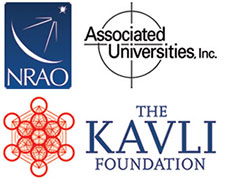
The NRAO is organizing a series of three conferences for the astronomy community to broadly discuss and make key decisions regarding potential U.S. futures for radio-millimeter-submillimeter (RMS) science in the 2020’s and beyond. Funded by the Kavli Foundation and Associated Universities, Inc. (AUI), the second conference in this series – hereafter “Futures 2” – was held 3-5 August 2016 at the Renaissance Harborplace Hotel in Baltimore, Maryland with 135 scientists in attendance from U.S. and international universities, observatories, and laboratories representing virtually every field of astrophysics.
The Futures I conference held 15-17 December 2015 was structured around key science themes that reflect community priorities identified in the New Worlds, New Horizons Astro2010 Decadal Survey that require RMS observations and facilities to address. Futures I yielded a compelling definition of the transformational science that interests the community and motivates the exploration of the scope and feasibility of the future RMS instrument and technique options.
Parallel sessions at Futures 2 broadly discussed potential RMS Flagship and Small/Midscale initiatives associated with the a next-generation Very Large Array (ngVLA), a Hydrogen Epoch of Reionization Array (HERA), the Cosmic Microwave Background (CMB), and pulsars. Flagship options are major investments with widespread community benefit and support that would require funding by or on a scale comparable to the National Science Foundation (NSF) – Major Research Equipment and Facility Construction program. Small/Midscale initiatives are investments that might be funded via the NSF Mid-Scale Initiative Program.
The ngVLA session at Futures 2 began with presentations on the general concept for the instrument, the transformational science to be done with it, and the technical challenges and choices to be addressed in its design. Breakout sessions were held to discuss and debate science cases and drivers on topics such as receiver bands, baseline lengths, and array configurations. The session culminated with the announcement of an ngVLA Community Studies program designed to facilitate community contributions to the instrument design, a call for nominations for membership on the ngVLA Science Advisory Council, and the preliminary announcement of an ngVLA science conference to be held in mid-2017.
Strong and compelling science cases were presented at the CMB and pulsar sessions of the Futures 2 conference. The strategy for developing HERA and detecting the Epoch of Reionization was presented in the HERA session.
Futures 3 is planned for August 2017 at a yet-to-be-determined location on the U.S. west coast.
ngVLA Community Studies Program & Science Advisory Council

As part of envisioning a well-designed and budgeted concept for a next generation Very Large Array (ngVLA) that will yield transformational science and open a broad swath of new discovery space in the coming decades, the National Radio Astronomy Observatory (NRAO) is pleased to announce two new community initiatives.
ngVLA Community Studies Program
The NRAO is pleased to issue a Call for ngVLA Community Studies that will enable the community to become major contributors to this effort. These studies will be carried out in Fiscal Year 2017 and will be vital to crafting a well-designed and budgeted concept for consideration by the full community as part of the Astro2020 Decadal Survey.
The proposal submission deadline is 30 September 2016. Pre-proposal telecons regarding this Community Studies Program will be hosted by the NRAO on 18 August 2016 (13:00 EDT) and 7 September 2016 (13:00 EDT). Telecon connection details will be available via the Program website beginning one week prior to each telecon. NRAO anticipates funding most accepted proposals at a modest level to offset publications page charges and travel expenses to a mid-2017 ngVLA Science Conference. Up to a half-dozen of the highest-impact Community Studies may be funded at a more significant level of $10K - $25K USD per award.
ngVLA Science Advisory Council
The NRAO solicits nominations for membership to an ngVLA Science Advisory Council (SAC) that will act as the interface between the scientific community and NRAO, providing feedback and guidance towards a comprehensive design for a next-generation cm-to-mm wave interferometer centered around the VLA site. Nominations and self-nominations are due by 14 Sep. We anticipate announcing the SAC members by 30 Sep.
Please send any questions regarding these ngVLA community opportunities to Eric Murphy. We hope that you will actively participate in these exciting efforts to enable transformational science at centimeter and millimeter wavelengths in the coming decades.
ALMA Program News
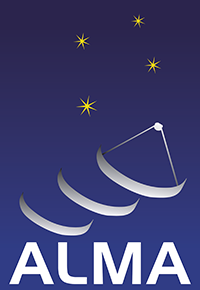
ALMA Cycle 4
The ALMA Cycle 4 observing proposal results were announced 8 August. A total of 707 proposals were selected for scheduling on ALMA from among the 1,573 proposals received in late April. There were 202 North American ALMA proposals among those approved. Two Large Projects were approved, including one led by a North American Principal Investigator (PI), with co-Investigators from other ALMA partners. Details regarding the accepted Cycle 4 proposals will appear at the ALMA Science Portal shortly.
Delivery of the Cycle 4 proposal results notification e-mails to ALMA PIs marks the initiation of Phase 2. Beginning with Cycle 4, PIs will create their Scheduling Blocks (SBs) with the assistance of ALMA Regional Center staff. For additional information regarding SB creation for Cycle 4, consult the User's Guide to ALMA Scheduling Blocks. The deadline for submission of Cycle 4 Scheduling Blocks is 15 September 2016, 15h UT.
Meetings & Conferences
The program for the major international science conference Half a Decade of ALMA: Cosmic Dawns Transformed has been crafted from the 200+ submitted abstracts. This conference will highlight exciting results from the first Principal Investigator Long Baseline campaign, the first ALMA deep fields and more, and will be held 20-23 September 2016 at the Renaissance Indian Wells Resort in Indian Wells, California, USA. The conference will bring together researchers from around the world to present and discuss ALMA's transformative science and to motivate collaborations for ALMA Cycle 5. Conference registration closes 22 August. Students can register for a reduced rate.
Free registration is open for a two-day ALMA Future Science Development Program Workshop that will be held in Charlottesville, Virginia 24-25 August 2016. The program is posted. Remote participation will be available via video and audio links.
The emphasis of this strategic Development Program Workshop – and subsequent Cycle 5 Call for Studies and Projects – will be on high-impact initiatives providing major advances in ALMA science through enhancements to sensitivity, instantaneous bandwidth and spectral coverage, spatial resolution, and imaging speed. An overview of the current ALMA Development Plan and its components will be featured at the Workshop.
Contingent on federal funding, the annual ALMA Development Program budget for development studies and projects in North America is $4.5M USD. The Cycle 5 ALMA Development Program is expected to include an integrated, multi-year award pool for North American development studies and projects that may total up to $14M USD.
Array Configurations
The ALMA array is now in the C40-5 configuration, with maximum baseline lengths of 1.1km, which yields a 0.5 arcsec beam size at 100 GHz. The final Cycle 3 configuration change will occur at the end of August 2016, when the the array will move to the C40-6 configuration (100GHz beam size, 0.3 arcsec). Cycle 4 observations will begin in October 2016. During Cycle 4, remaining Cycle 3 Grade A projects will have the highest priority, and be followed, in priority order, by Cycle 4 Grade A, Grade B, then Grade C projects, respectively.
Cycle 4 Call for North America ALMA Development Studies Results
North America issued a Call for Proposals for ALMA Development Studies on 1 March 2016, with proposals due 2 May 2016.
A panel of highly qualified members of the astronomical community reviewed the study proposals. To avoid conflict of interest, none of the review panel members are affiliated with NRAO. Panels submitted anonymous grades and rankings. The panel discussed the results in a telecon and arrived at a consensus ranking. A recommendation for the Cycle 4 Development Studies program was drafted, approved by the North America ALMA Office and NRAO, and consented by the National Science Foundation (NSF).
Six Studies from 32 proposers representing ten institutions were proposed for North American funding with the consent of NSF (see Table 1). These six studies were judged to have substantial potential for science impact while fitting within the Fiscal Year (FY) 2017 funding envelope of the ALMA Development Program and the broad outlines set by ALMA 2030. The proposed slate of Studies strives to aid the community in achieving its scientific objectives in the coming decade and address the following key ALMA development objectives:
- improve sensitivity and spectral grasp via improvements to the workhorse ALMA Band 6 receivers and substantial improvements to the ALMA Band 10 receivers;
- upgrade ALMA Band 3 receivers by lowering system noise and broadening the bandwidth of the critical 3mm band;
- a study on backend pathways for providing increased bandwidth;
- enhance functionality, including spectral line capability, for phased ALMA;
- provide a new viewer in the Common Astronomy Software Applications (CASA) package, with interactive selection of regions of interest and interoperability with CASA cleaning operations; and
- improve software that optimizes use of the combined ALMA 12m, compact, and total power arrays.
| Title | Investigators | Institutions |
|---|---|---|
| Development of 2nd Generation SIS Receivers for ALMA | Kerr, Mangum, Lichtenberger, Effland, Dindo, Srikanth | NRAO, UVA |
| Prototype of a Complete Dual-Linear 2SB Block and a Single-Polarization Balanced 2SB Block | Henke, Niranjanan, Knee | NRC-HIA |
| Digital Back End Antenna Article | Ford, Ashton, Gerrard, Langley, Revnell, Luce, Erickson, Lacasse, Saez, Carilli, Ricci | NRAO, JAO, CfA |
| Diversifying the Scientific Applications of the ALMA Phasing System | Matthews, Crew, Fish, Hecht, Doeleman | MIT |
| Cleaning Up Interactive Cleaning | Rosolowsky, Kern | U. Alberta, NRAO |
| Total Power Map to Visibilities | Koda, Teuben, Sawada, Plunkett, Brogan | Stony Brook, UMD, JAO, ESO, NRAO |
The Sizes of Lensed Dusty Star-forming Galaxies at High z
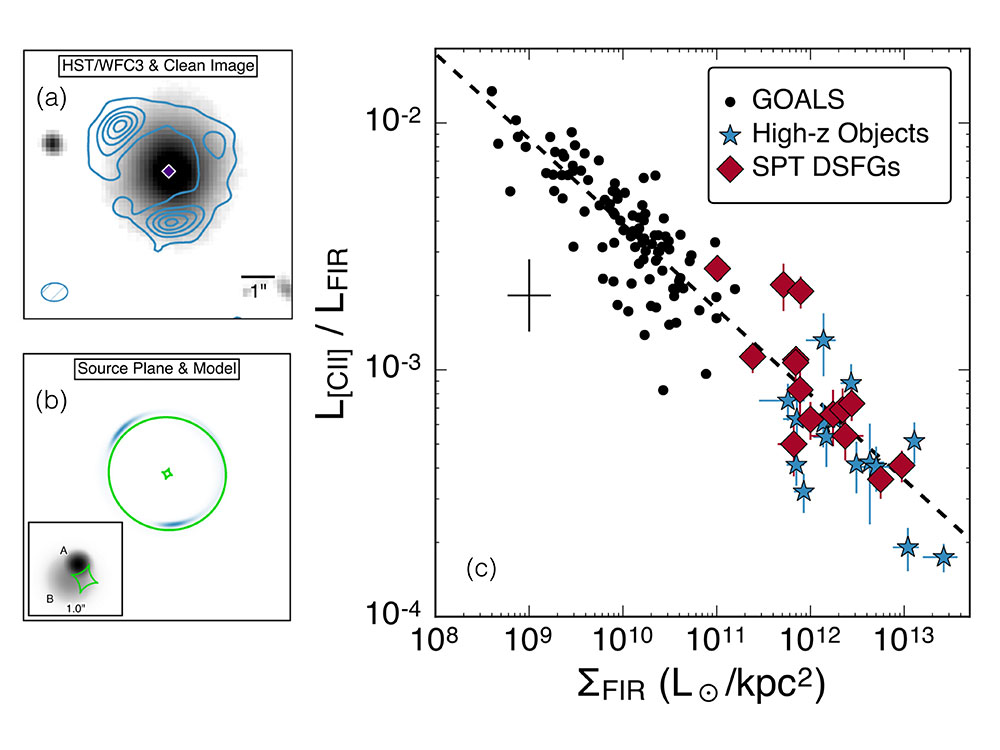
[a] an example DSFG, where contours of the ALMA 870 micron emission (the background galaxy) are superimposed on an optical HST image. The lens position is marked with the purple diamond. [b] Fully resolved best-fit model image (blue) with caustics (green) superimposed. The inset is a close-up of the source plane. [c] The [C II] deficit versus the far-IR surface brightness.
[click to enlarge]
Gravitational lensing has proven to be a powerful tool for observing high-redshift (z) galaxies that would otherwise be too faint to detect. High-resolution observations of these lensed systems allows for properties such as the lensing factor and the intrinsic size of the background galaxy to be measured. In the August 2016 Astrophysical Journal, Spilker and his collaborators present detailed modeling of 0.5" resolution, ALMA 870 micron observations of a sample of 47 lensed dusty star-forming galaxies (DSFG) discovered via their South Pole Telescope submillimeter survey (see Figure panels a and b). They find a median lensing magnification of 5.5 for the sample, and an intrinsic background galaxy size distribution comparable to the distribution of un-lensed high-z DSFGs. They also find that these lensed systems follow the [CII] 158 micron-to-far IR luminosity ratio versus far-IR surface brightness relation observed for low-redshift IR galaxies (see panel c), where the [CII] "deficit" is correlated with increasing surface brightness (no deficit is observed for normal star-forming galaxies). While the nature of the observed deficit in this major ISM coolant is not well understood, it is clearly correlated with the compactness of the active regions in these extreme star-forming galaxies relative to normal star-forming galaxies.
New NRAO EPO Assistant Director: Suzanne Gurton
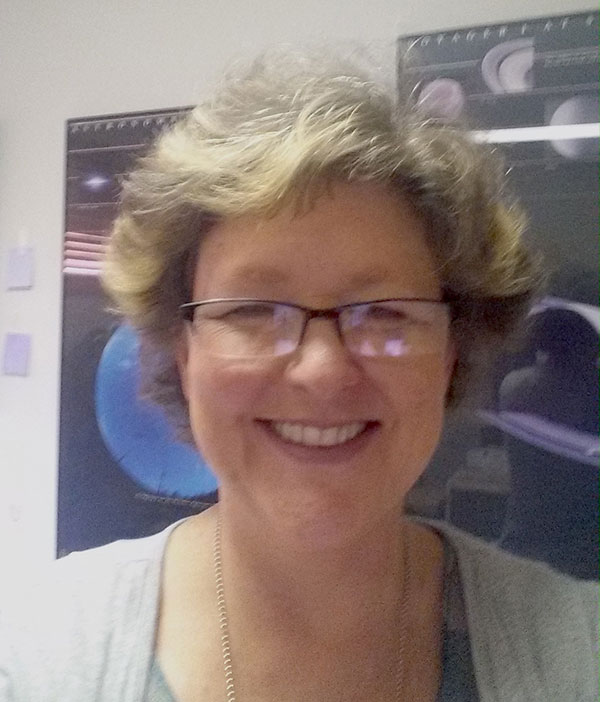
I am pleased to announce that Suzanne Gurton will be the next NRAO Assistant Director for Education & Public Outreach (AD – EPO).
Suzanne received a B.S. in astronomy from the University of Arizona and studied Science Curriculum and Instruction at the University of North Carolina – Chapel Hill while completing the Morehead Internship in Planetarium Operations. From 1984–2000, Suzanne gained experience via astronomy education and outreach positions she held at Griffith Observatory (Astronomical Lecturer), the University of Colorado (Production Supervisor), the American Museum of Natural History (Astronomical Writer/Producer), and Santa Fe Community College (Planetarium Director).
Since September 2000, Suzanne has been Education Manager and, more recently, Director of Education for the Astronomical Society of the Pacific (ASP), a recognized leader in astronomical education and public outreach. Suzanne has been a key contributor to the strategic direction and success of the ASP, crafting an innovative portfolio of science education programs, including many with national reach and impact. The ASP education programs led by Suzanne have delivered scientific insight and professional development to diverse audiences, including science museum educators, amateur astronomers, museum directors, interpretive park rangers, 4H leaders, and the science-attentive public. Suzanne will also bring to NRAO an impressive record of success in obtaining major grant funding from the NSF and NASA.
I would like to thank Tania Burchell for her leadership of the NRAO EPO team and program as interim AD – EPO over the past year.
Suzanne Gurton will arrive in Charlottesville and take up her position as Assistant Director for Education & Public Outreach on 21 September. Please join me in welcoming Suzanne to NRAO!
CASA on Amazon Web Services
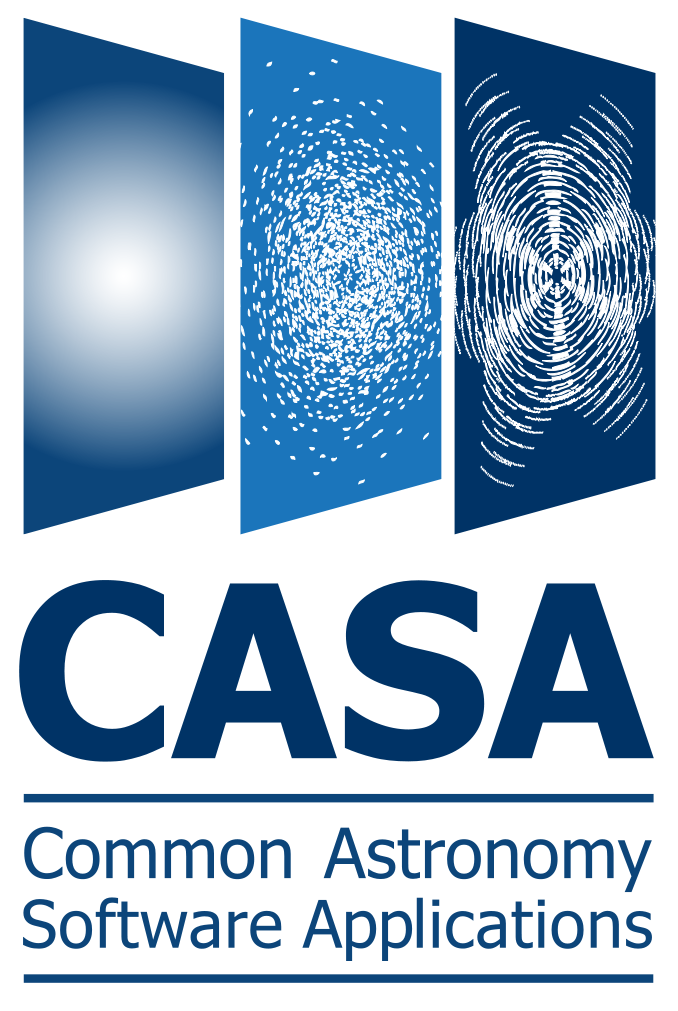
The NRAO is pleased to announce new on-line documentation covering the use of Amazon Web Services (AWS) computing resources for processing data with the Common Astronomy Software Applications (CASA) package. AWS is a collection of physical assets and software tools for using ad hoc computing resources (cloud computing) within Amazon. The combination of a wide range of processing hardware, network speeds, storage media, and tools allows users to create virtual computing platforms tailored to specific problem sizes.
AWS has the potential to provide substantial time savings via distributed processing across more resources than are typically available. NRAO has successfully run a simulation across 1000 AWS servers, for example, that reduced a 4000-hour duration serial execution to a 4+ hour parallel run. Because AWS charges on a per use basis, it may provide a cost savings for anyone investigating acquiring new hardware that would only experience periodic usage.
The new documentation covers the basics of AWS usage, resource selection, and cost considerations in the context of CASA-based processing and includes pointers into the vast AWS documentation repository. Over time, the documentation will be expanded to include more complex use cases and example scripts for automation. As this is a new processing model, and given the unique nature of AWS resources, please direct any questions or comments to nrao-aws@nrao.edu rather than to CASA or Helpdesk personnel.
Real-time, Commensal Fast Transient Searches at the VLA

While the Expanded Very Large Array (VLA) project produced dramatic improvements in sensitivity and frequency coverage, its legacy may be defined by the introduction of powerful and flexible digital signal processing. The power and flexibility of the VLA correlator makes it uniquely capable of doing a broad range of science today and growing to do the science of tomorrow.
One exciting pursuit for the VLA is the study of "fast radio bursts" (FRBs), a mysterious new class of millisecond radio transient. FRBs seem to come from far outside our galaxy, which would make them unusually luminous and novel probes of the intergalactic medium. As the most sensitive centimeter-wavelength radio interferometer on earth, the VLA will revolutionize this field with its ability to precisely localize sources to identify multi-wavelength counterparts (e.g., a host galaxy). Previously, our group has demonstrated that potential with the introduction of "fast imaging", a new concept for using the VLA as a high speed camera. Now, we are expanding on that concept with the construction of realfast, a 24 / 7 fast transient survey system at the VLA.
The core of realfast is a 32-node, Graphics Processing Unit-accelerated compute cluster that will perform real-time transient searches on millisecond timescales as data are received at the VLA, before averaging the data for archive storage. Real-time processing will allow us to rapidly identify transients and trigger recording of data for those brief moments when a transient candidate is detected. Triggered data recording reduces the data flow by orders of magnitude and makes it feasible to observe continuously. We will integrate this system with a duplicate high-speed data stream to turn each VLA observation into a fast transient survey, ultimately encompassing thousands of hours per year.
Realfast will be supported by a three-year grant from the National Science Foundation Advanced Technologies and Instrumentation program and developed in close collaboration with NRAO staff. Transient alerts and associated data products will be made public. This will make the VLA into a transient survey machine and help connect the public to our rapidly changing understanding of the rapidly changing sky.
For additional information, visit the realfast website.
GBT Remote Observing Training School
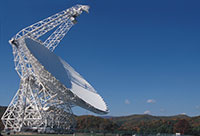
The Green Bank Observatory will host two Green Bank Telescope (GBT) Observer Training Schools in the coming year. The first will be held 24-28 October 2016, and the second will take place 15-19 May 2017. Each of these schools will concentrate on pulsar and spectral line (low and high frequency) observing techniques with the GBT.
Attendees are expected to have prior basic knowledge of astronomy, radio astronomy, and radio astronomy observing. GBT scientists will present information on observing, calibration, and data reduction techniques with the GBT, as well as the writing of effective GBT observing scripts. Much of the workshop will involve hands-on training with the GBT and GBT data. Lectures and projects will be aimed at the graduate student level. Attendees completing the workshop should be ready for remote GBT observing.
If you would like to attend either of these training sessions, please contact Toney Minter (tminter AT nrao.edu) to reserve a space. These remote training sessions will be held in Green Bank, West Virginia and, due to the hands-on nature of the training, space is limited.
Recent Media Releases
|
Magdalena Teacher, Students Begin Exchange Visit to Chile |
|
|
ALMA Explores the Magnetic Universe |
Career Opportunities
Assistant Scientist: The NRAO is actively seeking an Assistant Scientist who will work with the Algorithms R&D Group and the Common Astronomy Software Applications (CASA) group and will be expected to carry out research in developing algorithms relevant to the NRAO telescopes and their implementation, and to provide support and maintenance of the CASA package for delivery to the user community. The successful candidate will contribute to CASA development and maintenance as part of the CASA team. Work will require advanced programming in C++ and Python, use of the CASA package, and high performance computing. The position will be based in either Charlottesville, Virginia on the grounds of University of Virginia or in Socorro, New Mexico on the campus of New Mexico Tech.
Division Head - Electronics: The NRAO in Green Bank, West Virginia is actively seeking a Division Head for the Electronics Division. The successful candidate will become a member of the NRAO Green Bank Operations team that oversees the development and operation of the Robert C. Byrd Green Bank Telescope (GBT), the world’s largest fully-steerable telescope, as well as numerous other smaller telescopes that are used for a variety of scientific and educational purposes. Working at wavelengths ranging from 100cm through 3mm, the GBT supports a diverse portfolio of scientific research. The Electronics Division currently consists of 10 engineers and 9 technicians divided into two groups – microwave and digital, both of which have group leads. The Electronics Division Head is responsible for managing the Division as well as working with the other Division Heads in Green Bank to plan the future of the telescopes and facilities to optimize their scientific use.
Assistant Scientist: The NRAO is actively seeking an Assistant Scientist to be an active partner in working to increase communication between the Common Astronomy Software Applications (CASA) development team and the user community. The CASA package is the primary data reduction package for both the Karl G. Jansky Very Large Array (VLA) and Atacama Large Millimeter/submillimeter Array (ALMA), in addition to being used at other radio observatories around the world. It is expected that the successful candidate will conduct research using the CASA package. The position will be based in either Charlottesville, Virginia on the grounds of University of Virginia or in Socorro, New Mexico on the campus of New Mexico Tech.
Research Engineer in Millimeter and Submillimeter Wavelength Electronics: The NRAO in Charlottesville, Virginia invites applicants who are research engineers with expertise in millimeter/sub-millimeter wavelength electronics. The successful candidate will be a member of the NRAO Scientific Staff and will join the millimeter/sub-millimeter receiver group in the Central Development Laboratory (CDL) in Charlottesville, Virginia. She/he will play a leading role in a program of design and development of low-noise millimeter/sub-millimeter wavelength instrumentation for astrophysical observation. This has been identified by NRAO as a key technology area for the next generation of radio telescope instrumentation.
For additional information on these openings and other NRAO career opportunities, please visit the NRAO – Career Opportunities web pages.
From the Archives
Ellen Bouton

[click to enlarge]
About this month's photograph: Bill Harris (NSF), Hugh Van Horn (NSF), and NRAO Director Paul Vanden Bout standing on level ground at the 16,500 foot Millimeter Array (MMA), later Atacama Large Millimeter/submillimeter Array (ALMA), site, with 20,000 foot mountains rising in the background.
In a long article in the Fall 1997 issue of Point Source, the NRAO internal newsletter, prompted by Congressional approval of the National Science Foundation Fiscal Year 1998 budget, which included design and development funding for the Millimeter Array, the late Bob Brown wrote:
"Further partnership and cooperative involvement in the MMA is very likely. The NSF would like to see the MMA done as a partnership between their agency (through the NRAO) and another governmental agency or an international partner. Discussions, some quite far along, are being held with both the Japanese National Astronomical Observatory and the European Southern Observatory. These may lead to the MMA being done collaboratively and being expanded well beyond the scale of the project that we have been imagining heretofore. Such partnerships, should they come to pass, will have little effect on our near-term development plans but perhaps profound effects on the long-term evolution of the MMA project."
From the Archives is an ongoing series illustrating NRAO and U.S. radio astronomy history via images selected from our collections of individuals' and institutional papers. If readers have images they believe would be of interest to the Archives, please contact Ellen Bouton.

